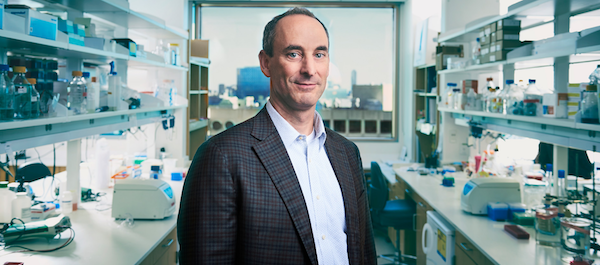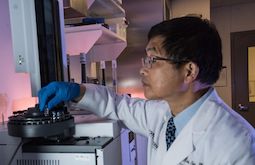G.C. Broughton Jr. Foundation $1 million gift bolsters innovative Alzheimer’s research

Dr. Marc Diamond
By Sharon Reynolds
A $1 million gift from the G.C. Broughton Jr. Foundation will support Alzheimer’s research at UT Southwestern’s Peter O’Donnell Jr. Brain Institute, specifically supporting Dr. Marc Diamond’s investigations into the role of the tau protein in neurodegenerative disorders. Dr. Diamond’s work promises to lead to new discoveries, which potentially could have meaningful impacts on the longevity and quality of life for people with Alzheimer’s disease and their families.
“We have all witnessed the destruction of Alzheimer’s on our loved ones, friends, and neighbors,” said Mrs. Jean Broughton-Powell, President of the G.C. Broughton Jr. Foundation. “My wish is that someday no family will have to experience the loss of a vibrant life or suffer the physical and emotional burdens of this disease. With this gift, I am encouraged that Dr. Diamond’s team will come up with new ways to diagnose, treat, and prevent this most tragic of disorders.”
The work of Dr. Diamond, founding Director of the Center for Alzheimer’s and Neurodegenerative Diseases, is accelerating disease treatments including drug development. Abnormalities in the tau protein are an indicator of Alzheimer’s, and Dr. Diamond has uncovered the precise point in the disease process in which healthy tau becomes toxic, but has not yet begun forming deadly tangles in the brain. This finding offers hope that one day we will be able to detect Alzheimer’s before it takes hold and develop treatments that stabilize tau proteins before they become toxic.
“I’ve been working in this field for 17 years, and this is perhaps the most exciting discovery I have made,” Dr. Diamond said. “We have much insight now into the structure that discriminates the good from bad forms of tau, which should allow us to make new therapies to prevent the formation of bad tau, clear it away, or detect it at the earliest stages of the disease, long before anyone experiences symptoms.”
Dr. Diamond describes Alzheimer’s as the single biggest looming threat to our country’s health care system and said new treatments are desperately needed. “Currently there are about 5 million people with Alzheimer’s. That number is expected to triple in the next 30 years, and this one disease could exhaust the Medicare budget.”
The Broughton Foundation gift will allow further investigation into tau to explore gene therapy, imaging technology, and personalized medicine and other treatments for Alzheimer’s.
Gene therapy

Dr. Rachel Bailey
The sooner physician-scientists can detect changes in tau, the quicker they can intervene – and the greater the benefit to patients. Dr. Diamond is collaborating at UT Southwestern with Dr. Rachel Bailey, Assistant Professor in Pediatrics and the Center for Alzheimer’s and Neurodegenerative Diseases, who is working on a two-pronged gene therapy targeting tau. She hopes that her research to develop a one-time injection to simultaneously destroy toxic tau that is present in cells and replace it with new, cluster-resistant tau that could live for the lifetime of a cell will lead to the initiation of a Phase 1 clinical trial.
“Since the gene therapy I’m developing targets the tau protein itself, it has the potential to help fight Alzheimer’s disease, as well as a whole host of diseases in which tau is implicated, including some forms of frontotemporal dementias and Parkinson’s disease,” Dr. Bailey said. “I believe we are now at an age where we have the technology to make meaningful impacts on these diseases. We are just beginning to see the potential benefits of gene therapy because with each clinical trial, with each new discovery we make, we can continuously improve.”
In the future, physicians also will be able to conduct genetic testing to determine risk for Alzheimer’s and develop the optimal treatment for patients before the onset of symptoms.
Imaging technology

Dr. Xiankai Sun
The innovation of sophisticated imaging technologies has enabled safer, more precise, and less invasive methods to see inside the body. Presently, there is no established way to differentiate the good from bad forms of tau through imaging. Dr. Diamond is working with Drs. Rajiv Chopra, Bhavya Shah, and Xiankai Sun to develop diagnostic imaging tracers that will allow scientists to visualize tau, ideally before symptoms occur, and monitor its progression. Dr. Chopra is Associate Professor, Radiology and Advanced Imaging Research Center, Director of 3D Modeling & Imaging, and Director of Image-Guided Therapy Development. Dr. Shah is Assistant Professor of Radiology, Neurological Surgery, and Advanced Imaging Research Center. Dr. Sun is Professor of Radiology and Advanced Imaging Research Center and Director of the Cyclotron and Radiochemistry Program.
“Healthy humans have a baseline, and if something appears above the baseline as time goes on, imaging allows us to identify contrast,” Dr. Sun said. “Our goal is to catch disease initiation or progression early to buy time for more efficient treatments and extend life.” Highly sensitive neuroimaging is critical to determining if new therapies for Alzheimer’s are effective. The development of new imaging agents has the potential to shave years off the typical timeline for clinical trials, which will make promising therapies available more quickly to patients.
Personalized medicine
The Broughton Foundation gift will support the collection and analysis of patients’ clinical data – including blood samples and brain images – that can be put into a research database for ongoing analyses. Understanding the specific mechanism of disease in each patient will enable scientists to test a targeted therapy based on an individual patient’s clinical and biological markers and provide personalized medicine.
“Progress in efforts to understand the role of tau in Alzheimer’s disease and to translate these insights into clinical advances enables investigators to tackle problems that cut across departmental boundaries,” said Dr. Daniel K. Podolsky, President of UT Southwestern. “Investigators at UT Southwestern from multiple disciplines bring their expertise to bear and, together, are making many important contributions to scientific advances in health and wellness. These efforts are made possible by the generosity and vision of donors like the G.C. Broughton Jr. Foundation.”
Dr. Diamond holds the Distinguished Chair in Basic Brain Injury and Repair.
Dr. Podolsky holds the Philip O’Bryan Montgomery, Jr., M.D. Distinguished Presidential Chair in Academic Administration, and the Doris and Bryan Wildenthal Distinguished Chair in Medical Science.
Dr. Sun holds the Dr. Jack Krohmer Professorship in Radiation Physics.